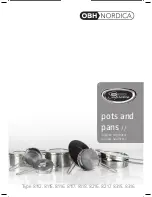
2
Always be certain that the controls are in the OFF position
when the oven is not in use, and before attempting to clean
the cooker.
n
n
When the oven is on, DO NOT leave the oven door
open for longer than necessary, otherwise the
control knobs may become very hot.
n
n
When using the grill, make sure that the grill pan
is in position and pushed fully in, otherwise the
control knobs may become very hot.
n
n
DO NOT use harsh abrasive cleaners or sharp metal
scrapers to clean the
oven door glass since they can
scratch the surface, which may result in shattering of
the glass.
Always keep combustible materials, e.g. curtains, and
flammable liquids a safe distance away from your cooker.
n
n
DO NOT spray aerosols in the vicinity of the cooker
while it is on.
Use dry oven gloves when applicable – using damp gloves
might result in steam burns when you touch a hot surface.
Do not use a towel or other bulky cloth in place of a glove – it
might catch fire if brought into contact with a hot surface.
n
n
NEVER operate the cooker with wet hands.
n
n
DO NOT use aluminium foil to cover shelves, linings
or the oven roof.
n
n
DO NOT use hotplate protectors, foil or hotplate
covers of any description. These may affect the safe
use of your hotplate burners and are potentially
hazardous to health.
n
n
NEVER heat unopened food containers. Pressure
build up may make the containers burst and cause
injury.
n
n
DO NOT use unstable saucepans. Always make sure
that you position the handles away from the edge of
the hotplate.
n
n
DO NOT use cooking vessels on the hotplate that
overlap the edges.
Never leave the hotplate unattended at high heat settings.
Pans boiling over can cause smoking, and greasy spills may
catch on fire. Use a deep fat thermometer whenever possible
to prevent fat overheating beyond the smoking point.
n
n
WARNING!
Unattended cooking on a hob with fat or oil can be
dangerous and may result in fire.
n
n
NEVER leave a chip pan unattended. Always heat fat
slowly, and watch as it heats. Deep fry pans should
be only one third full of fat. Filling the pan too full
of fat can cause spill over when food is added. If you
use a combination of oils or fats in frying, stir them
together before heating, or as the fats melt.
Foods for frying should be as dry as possible. Frost on frozen
foods or moisture on fresh foods can cause hot fat to bubble
up and over the sides of the pan. Carefully watch for spills or
overheating of foods when frying at high or medium high
temperatures. Never try to move a pan of hot fat, especially a
deep fat fryer. Wait until the fat is cool.
Do not use the top of the flue (the slots along the back of
the cooker) for warming plates, dishes, drying tea towels or
softening butter.
n
n
DO NOT use water on grease fires and never pick
up a flaming pan. Turn the controls off and then
smother a flaming pan on a surface unit by covering
the pan completely with a well fitting lid or baking
tray. If available, use a multi-purpose dry chemical
or foam-type fire extinguisher.
Cooking high moisture content foods can create a ‘steam
burst’ when the oven door is opened
(Fig.1-1)
. When
opening the oven stand well back and allow any steam to
disperse.
Take care that no water seeps into the appliance.
n
n
This appliance is heavy so take care when moving it.
Ceramic Hotplate Care
n
n
NEVER cook directly on the hotplate surface.
n
n
DO NOT use the hob surface as a cutting board.
Do not leave utensils, foodstuffs or combustible items on
the hob when it is not in use (e.g. tea towels, frying pans
containing oil).
n
n
DO NOT place plastic or aluminium foil, or plastic
containers, on the hotplate.
n
n
DO NOT leave the hotplate switched on unless being
used for cooking.
Do not stand or rest heavy objects on the hotplate. Although
the ceramic surface is very strong, a sharp blow or sharp
falling object (e.g. a salt cellar) might cause the surface to
crack or break
(Fig.1-2)
.
n
n
Should a crack appear in the surface, disconnect the
cooker immediately from the supply and arrange for
its repair.
Always LIFT pans off the hotplate. Sliding pans may cause
marks and scratches
(Fig.1-3)
. Always turn the control to the
‘OFF’ position before removing a pan.
DO NOT
place anything between the base of the pan and
the hotplate surface (e.g. asbestos mats, aluminium foil, wok
stand).
n
n
Objects such as pan lids and items with thin bases
including kettles, may stick to the ceramic surface.
In the unlikely event that this happens DO NOT
attempt to lift or lever the item to remove, as this
may cause damage to both the item and the ceramic
surface. Remove objects by carefully sliding to the
hob perimeter. Damage caused by incorrect removal
will not be covered under the terms of the warranty.







































